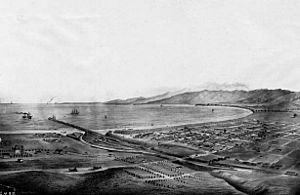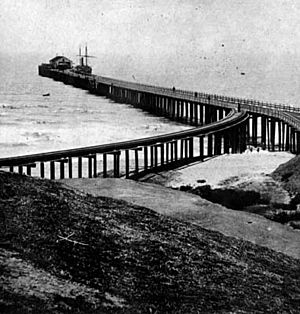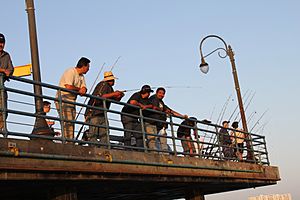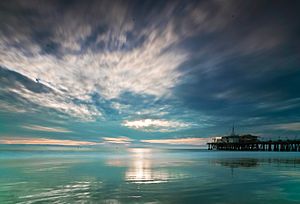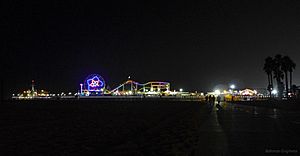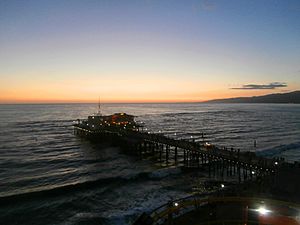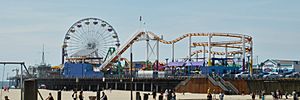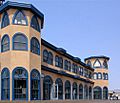Santa Monica Pier facts for kids
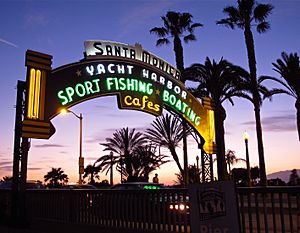
Landmark entrance to the Santa Monica Pier
|
|
| Type | Amusement Pier |
|---|---|
| Spans | Pacific Ocean |
| Locale | Santa Monica, California, U.S. |
| Opening date | September 9, 1909 |
| Coordinates | 34°00′31″N 118°29′55″W / 34.00861°N 118.49861°W |
| Designated | August 17, 1976 |
The Santa Monica Pier is a large double-jointed pier at the foot of Colorado Avenue in Santa Monica, California, United States. It contains a small amusement park, concession stands, and areas for views and fishing.
Attractions
Pacific Park
The pier contains Pacific Park, a family amusement park with its solar panelled Ferris wheel. The brightly lit wheel can be seen from a distance and has been turned off during the Earth Hour observance.
Other attractions
It also has an original carousel hippodrome from the 1920s, the Santa Monica Pier Aquarium operated by Heal the Bay, shops, entertainers, a video arcade, a trapeze school, pubs, and restaurants. The pier's west end is a popular location for anglers.
The pier is a venue for outdoor concerts, movies, and other activities.
History

Santa Monica has had several piers; however, the current Santa Monica Pier is made up of two adjoining piers that long had separate owners. The long, narrow Municipal Pier opened September 9, 1909, primarily to carry sewer pipes beyond the breakers, and had no amenities. The short, wide adjoining Pleasure Pier to the south, a.k.a. Newcomb Pier, was built in 1916 by Charles I. D. Looff and his son Arthur, amusement park pioneers. Attractions on the Pleasure Pier eventually included the Santa Monica Looff Hippodrome building (which now houses the current carousel and is listed on the National Register of Historic Places), the Blue Streak Racer wooden roller coaster (which was purchased from the defunct Wonderland amusement park in San Diego), the Whip, merry-go-rounds, Wurlitzer organs, and a funhouse.
The Philadelphia Toboggan Company built the Carousel, PTC #62, in 1922. It features 44 hand-carved horses. It was rebuilt in 1990 inside the Hippodrome. A calliope provides musical accompaniment.
The La Monica Ballroom opened on July 23, 1924. Designed by T.H. Eslick with a Spanish façade and French Renaissance interior, it was the largest dance hall on the west coast, accommodating 5,000 dancers on its 15,000-square-foot (1,400 m2) hard maple floor. Country music star Spade Cooley began broadcasting his weekly television show from the ballroom in 1948, where the program remained until 1954. In the summer of 1955, the Hollywood Autocade opened at the La Monica with one-hundred famous and unusual cars, including Jack Benny's Maxwell and a Rumpler Drop Car. From 1958 until 1962, the ballroom served as a roller skating rink; first as Skater's Ballroom, and later as the Santa Monica Roller Rink, where the speed skating club won many state and regional championships. The La Monica Ballroom was demolished in 1963.
The Pleasure Pier thrived during the 1920s but faded during the Great Depression. During the 1930s, most of the amusement park facilities were closed down and its attractions sold off. A breakwater was built in 1934 that provided docking for up to 100 fishing and pleasure boats near the pier.
The bridge and entry gate to Santa Monica Pier were built in 1938 by the federal Works Project Administration, and replaced the former grade connection.
The Newcomb Pier was privately owned until it was acquired by the city in 1974. During the 1960s and 1970s various plans were proposed that would entail removal of the pier. The most extensive included the construction of an artificial island with a 1500-room hotel. It was approved by the City Council, but citizens formed "Save Santa Monica Bay" to preserve the pier. The order to raze the pier was revoked by the city council in 1973. Within that same year, the Carousel and Hippodrome were sets for the film The Sting.
Storms swept away the protective breakwater in 1982. During storms in early 1983, the pier experienced a significant loss. On January 27, there were reported swells of 10-feet during this winter storm. When the storm was over, the lower deck of the pier was destroyed. The City of Santa Monica began repairs on March 1, 1983, when another storm rolled in. A crane which was being used to repair the west end was dragged into the water and acted as a battering ram against the pilings. Over one-third of the Pier was destroyed.
On June 18, 2009, the California Office of Environmental Health Hazard Assessment issued a safe eating advisory for any fish caught from Santa Monica Pier to Ventura Harbor due to elevated levels of mercury and PCBs.
Management
The City of Santa Monica created a non-profit in response to the damage and called it Santa Monica Pier Restoration Corporation (SMPRC). SMPRC conducted the daily operations of the Santa Monica Pier, such as managing events, filming, promotions, tenants, and street performers. SMPRC has produced the Santa Monica Pier Paddle Board Race and the Twilight Summer Concert Series. Also, in 2011, SMPRC changed the company name to the Santa Monica Pier Corporation (SMPC).
Climate
| Climate data for Santa Monica Pier, CA | |||||||||||||
|---|---|---|---|---|---|---|---|---|---|---|---|---|---|
| Month | Jan | Feb | Mar | Apr | May | Jun | Jul | Aug | Sep | Oct | Nov | Dec | Year |
| Record high °F (°C) | 85 (29) |
89 (32) |
90 (32) |
91 (33) |
89 (32) |
92 (33) |
91 (33) |
95 (35) |
94 (34) |
99 (37) |
100 (38) |
89 (32) |
100 (38) |
| Mean maximum °F (°C) | 76.9 (24.9) |
76.1 (24.5) |
74.5 (23.6) |
75.6 (24.2) |
73.0 (22.8) |
74.8 (23.8) |
77.5 (25.3) |
77.5 (25.3) |
81.7 (27.6) |
83.3 (28.5) |
80.8 (27.1) |
76.6 (24.8) |
89.4 (31.9) |
| Mean daily maximum °F (°C) | 64.1 (17.8) |
63.7 (17.6) |
63.4 (17.4) |
64.5 (18.1) |
65.4 (18.6) |
68.1 (20.1) |
71.0 (21.7) |
72.1 (22.3) |
72.1 (22.3) |
70.4 (21.3) |
68.0 (20.0) |
64.8 (18.2) |
67.3 (19.6) |
| Mean daily minimum °F (°C) | 49.2 (9.6) |
49.9 (9.9) |
50.8 (10.4) |
55.6 (13.1) |
55.6 (13.1) |
58.4 (14.7) |
61.2 (16.2) |
62.2 (16.8) |
61.4 (16.3) |
58.2 (14.6) |
53.6 (12.0) |
49.7 (9.8) |
55.5 (13.0) |
| Mean minimum °F (°C) | 41.8 (5.4) |
43.3 (6.3) |
44.2 (6.8) |
46.3 (7.9) |
50.3 (10.2) |
53.8 (12.1) |
57.0 (13.9) |
57.7 (14.3) |
56.1 (13.4) |
51.9 (11.1) |
45.9 (7.7) |
42.3 (5.7) |
40.4 (4.7) |
| Record low °F (°C) | 34 (1) |
35 (2) |
33 (1) |
39 (4) |
43 (6) |
45 (7) |
49 (9) |
51 (11) |
44 (7) |
42 (6) |
37 (3) |
34 (1) |
33 (1) |
| Average precipitation inches (mm) | 2.69 (68) |
3.01 (76) |
2.03 (52) |
0.73 (19) |
0.17 (4.3) |
0.03 (0.76) |
0.02 (0.51) |
0.08 (2.0) |
0.15 (3.8) |
0.33 (8.4) |
1.36 (35) |
2.04 (52) |
12.64 (321.77) |
| Source: https://wrcc.dri.edu/cgi-bin/cliMAIN.pl?ca7953 | |||||||||||||
Images for kids
-
Looff Hippodrome on the pier.
-
View of Santa Monica from the pier.
-
Ferris wheel light show at night, 2009.
-
U.S. Route 66 sign on the pier


